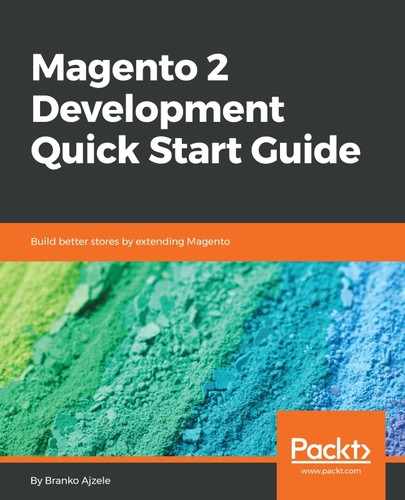Chapter 1, Understanding the Magento Architecture, takes a look at some of the key Magento components. We will go through plugins and event observers and learn how they provide a powerful way of extending Magento, either by changing the behavior of existing functions or by running some follow-up code in response to certain events.
Chapter 2, Working with Entities, demonstrates how to differentiate between the three types of Magento models: non-persistable, persistable simple, and persistable EAV. We will take a look at the six different setup scripts and how they allow us a great deal of flexibility for schema and data management.
Chapter 3, Understanding Web API, shows the reader how to differentiate between types of web API users, authentication, and methods it provides. We will also take a look at how easy it is to create our own APIs with just a few lines of XML. We will see how the route definition allows for easy binding between what arrives via HTTP requests and what is executed in code, respecting the access list permissions in the process.
Chapter 4, Building and Distributing Extensions, discusses how to create a simple shipping module. We shall take a look at how easy it is to add specific shipping calculations as part of offline shipping methods. We will then package this module and distribute it via Packagist. This makes it easy for the end consumer to use our module with just a few simple console commands.
Chapter 5, Developing for Admin, walks the reader through building two very different screens in the Magento admin area. One utilizes the listing component, whereas the other utilizes the form component.
Chapter 6, Developing for Storefront, covers the bits and pieces involved in storefront development, which JS components make the most challenging part of. We will understand how to write new components, as well as how to override or bypass existing ones – an essential skill for any Magento developer, be it backend or frontend.
Chapter 7, Customizing Catalog Behavior, demonstrates building three distinctive functionalities, all of which relate to the catalog part of Magento. They demonstrate how easily Magento can be extended with new features without really overriding any of the core files. Using plugins and JS components are just some of the approaches we might take.
Chapter 8, Customizing Checkout Experience, demonstrates writing a small but functional order notes module. This will allow us to familiarize ourselves with an important aspect of customizing the checkout experience, the gist of which lies in understanding the checkout_index_index layout handle, the JavaScript window.checkoutConfig object, and uiComponent.
Chapter 9, Customizing Customer Interactions, walks the reader through building a small module that allows us to get a greater insight into Magento's customer data and sections mechanism. We will learn how to manage and build a single component, which will get used both on the customer's My Account page, as well as at the checkout.
